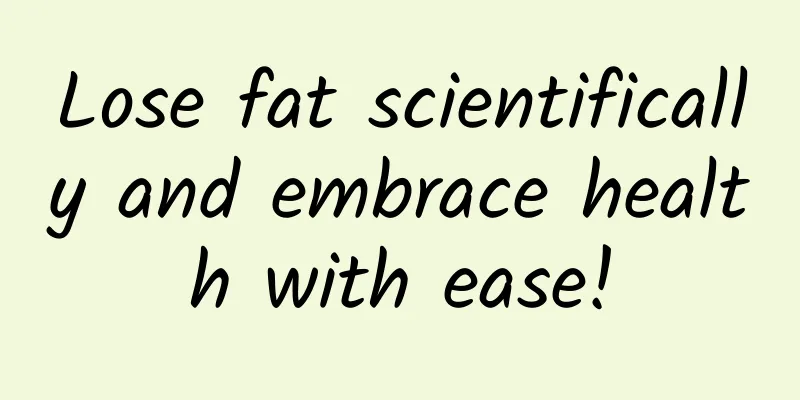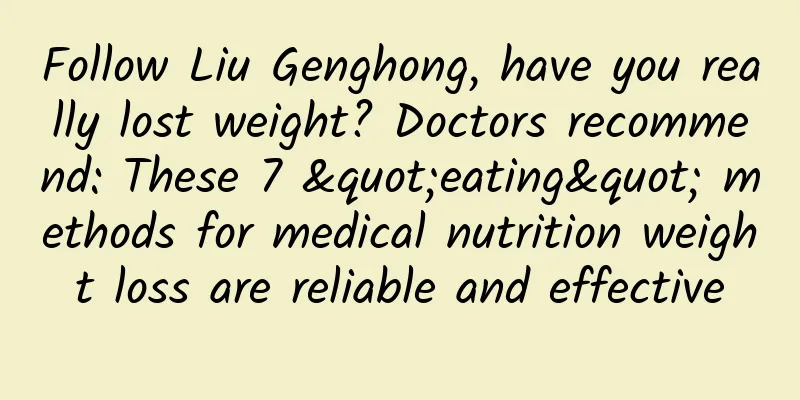Lose fat scientifically and embrace health with ease!

|
Author: Hu Bingjie Zhou Yi Xi'an Medical College Reviewer: Xiao Xinli, Associate Professor of Xi'an Jiaotong University In this era where thinness is considered beautiful, many people are troubled by obesity and are always clamoring to lose weight. The most important way to lose weight is to lose fat, but there are so many fat-loss strategies on the Internet that it is dizzying. Some are not detailed enough, and some are not scientific and rigorous enough. How should we choose? Today, let's teach you how to lose fat scientifically. Figure 1 Copyright image, no permission to reprint How to determine whether you need to lose fat? If you want to know whether you need to lose fat, the first step is to determine whether your body mass index (BMI) is within the normal standard. BMI is a commonly used indicator internationally to measure the degree of fatness and health of the human body. Calculation method BMI=weight/height² (kg/m²). 2. Judgment Criteria According to the recommendations of the Dietary Guidelines for Chinese Residents (2022), the normal BMI range for healthy adults in my country (18-64 years old) is 18.5kg/m²≤BMI<24kg/m². BMI<18.5kg/m² is thin and needs nutritional supplements to gain weight; 24kg/m²≤BMI<28kg/m² is overweight, and BMI≥28kg/m² is obese, so you need to pay attention to weight control. The appropriate weight and BMI for people over 65 years old should be slightly higher (20-26.9 kg/m²). How to lose fat scientifically? 1. Learn to calculate calories 1. Heat Unit We often use kilojoules (KJ) or kilocalories (kcal) to measure the calories provided by food or nutrients. 1 kcal = 4.18KJ. 1 gram of protein has 4 kcal, 1 gram of fat has 9 kcal, and 1 gram of carbohydrate has 4 kcal. 2. Estimation of human basal metabolism The state of the human body at room temperature of 18-25℃, fasting, lying flat, awake and quiet is called the basal state. At this time, the minimum energy metabolism required to maintain basic life activities such as heartbeat and breathing is called basal metabolism. There are many calculation formulas for basal metabolism. The most classic calculation formula for basal metabolism of a healthy body is the Harris-Benedict formula: Male (kcal/d) = 66 + 13.7×weight (kg) + 5.0×height (cm) - 6.8×age (y) Female (kcal/d) = 655 + 9.6×weight (kg) + 1.85×height (cm) - 4.7×age (y) Eat enough for your basal metabolic needs every day, and at the same time, eat a balanced diet to supplement the carbohydrates, fats, and proteins your body needs. This will ensure metabolic power and allow you to lose weight healthily. 3. If you want to lose fat, you also need to understand how our body consumes energy (1) Basal metabolic energy consumption. (2) Daily activities and exercise consumption, such as walking and exercising every day. As long as the muscles contract, energy will be consumed. (3) Thermic effect of food, which refers to the amount of calories consumed in the process of consuming food. At this point, you may have questions: how many calories does a person consume in total every day? Here we need to determine the exercise metabolic coefficient, which is an energy consumption coefficient summarized based on the different activity intensities of each person per week. It describes the extra energy used by the human body to support physical activity during exercise. Almost no exercise = 1.2, exercise 1-2 times a week = 1.375, exercise 3-5 times a week = 1.55, exercise 6-7 times a week = 1.725. Daily calorie consumption = basal metabolism × exercise metabolism coefficient. As long as the daily calorie intake is less than the calorie consumption, a "calorie gap" will be created. If the calorie gap is maintained at 10%~20%, you can lose weight healthily. Figure 2 Copyright image, no permission to reprint Note: The above data are only estimates. If you want more detailed data, you can go to the hospital for a check-up and conduct a comprehensive measurement based on body fat percentage, muscle content and the results of professional instruments. 2. Reasonably match food and maintain nutritional balance Our daily diet contains seven nutrients: water, protein, carbohydrates, vitamins, fats, dietary fiber, and minerals. Carbohydrates, lipids, and proteins can release energy after being oxidized in the body, so they are also called energy-generating nutrients. Figure 3 Copyright image, no permission to reprint During the fat loss period, we should reasonably match these seven nutrients, eat more high-quality protein, choose low-glycemic foods, and stay away from high-calorie junk foods such as fried and puffed foods. Only by eating enough daily basal metabolism can we lose weight reasonably and healthily. 3. Maintain good living habits In addition to a proper diet during fat loss, good living habits are also essential, such as a healthy sleep schedule, moderate exercise, regular meals, a relaxed and happy mood, quitting smoking and drinking, a light diet, chewing slowly, drinking plenty of water, etc. These can ensure that we reduce stress and anxiety, have a healthy body and plenty of energy to lose fat scientifically. 4. Scientific Movement 1. Our usual exercise can be roughly divided into two categories: aerobic exercise and anaerobic exercise. When the amount of exercise is not large, such as jogging, brisk walking, swimming, etc., the body's energy supply mainly comes from the aerobic metabolism of sugar. This kind of exercise is what we call aerobic exercise, which has the characteristics of low intensity, rhythm, uninterrupted, and long duration. When the exercise we are engaged in is very intense, or it breaks out rapidly, such as weightlifting, 100-meter sprint, wrestling, muscle machine training, etc., the body needs a lot of energy in an instant, and under normal circumstances, aerobic metabolism cannot meet the body's needs at this time, so sugar undergoes anaerobic metabolism to quickly produce a lot of energy. Exercise in this state is anaerobic exercise. 2. Exercise sequence: warm-up → anaerobic exercise → aerobic exercise → stretching and relaxation. 3. Aerobic exercise can fully burn body fat and help reduce fat, while anaerobic exercise can exercise muscles and beautify the body. Doing more effective exercise and combining aerobic and anaerobic exercise can easily help us reduce fat scientifically. How to avoid wrong ways to lose fat? Having said so much, I believe everyone has a certain understanding of how to lose fat scientifically. So, let’s take a look at the following wrong ways of losing fat and see if you have ever fallen for them. 1. Dieting to lose weight: Many people choose not to eat staple foods, breakfast and dinner, or even the popular "liquid fasting" diet method on the Internet (i.e. only eating liquids or foods that were liquid before processing, cutting off all solid foods, but not more than 1,200 calories a day). These are all unhealthy. Relying on hunger to lose weight and not eating enough for daily basal metabolism will cause malnutrition and a lower basal metabolic rate. Moreover, people with weak wills often cannot control overeating after dieting, and are very likely to rebound. 2. Trusting "three no" weight loss drugs: People often say "control your mouth and move your legs", and the two biggest stumbling blocks on the road to weight loss are laziness and greed. If you don't want to control your diet or take the initiative to exercise, some people will think of taking weight loss drugs, and various "three no" drugs claiming to be able to lose weight are emerging online. However, clinical drug treatment has very strict medication standards, and it is necessary to use drugs regularly under the guidance of a doctor. Don't trust "three no" weight loss drugs. 3. Vomiting to lose weight: Some people who try to lose weight will begin to regret and force vomiting after eating delicious food. However, they do not know that long-term vomiting can bring many harms, such as malnutrition, electrolyte imbalance, esophageal damage, tooth corrosion, etc. 4. Relying on vibration belts, fat-shaking machines, etc.: Obesity is caused by the fact that excess calories are not consumed and converted into fat. Passive exercise such as vibration belts and fat-shaking machines cannot consume calories, and long-term use of violent vibrations will also affect the functions of internal organs and bones. "A three-foot-thick ice doesn't freeze overnight." Fat loss requires perseverance and long-term persistence to be effective. Let's get rid of procrastination, don't just save it without taking action, and start losing fat scientifically from now on. |
<<: Are peppers, green onions, and onions the same kind of spicy? The answer is...
>>: "Buzz buzz buzz", next time you hear the sound of a mosquito, remember to slap it hard!
Recommend
MINISO Private Domain Operation Guide!
In the era of new retail and digitalization, many...
National security cannot be sold out. Five departments jointly issued a document: Automobile data shall not be provided overseas
The official conclusion has finally been reached ...
Baidu Aicaigou bidding ranking rules
First, let’s briefly talk about the two ways of B...
Scientific rumor-busting | The chemistry in fireworks and firecrackers
General Secretary Xi Jinping pointed out: "S...
Spodoptera exigua: What I hate most is people calling me a “caterpillar”!
When the larvae of the spiral moth sprout, you ca...
Dryness alert! How can the elderly avoid the spring "desert skin" dilemma?
Skin itching is one of the most common symptoms o...
When you have insomnia or can’t sleep, does closing your eyes and “squinting” count as resting?
The cover image of this article comes from the co...
How to avoid invalid traffic and improve traffic quality in bidding promotion?
Today’s sharing content is about the details of d...
The specific practice of "growth hacking": how to "acquire more users"
The theory of "growth hacking" has beco...
You are also using this kitchen gadget! Be careful of "explosion"
Air fryer As a new kitchen "artifact" H...
Chery and Haier jointly build the automotive industrial Internet and create an international "double-cross" platform
Chery Holding Co., Ltd. and Haier Group have sign...
Where is the small county in Zhejiang that is “least like Zhejiang”?
Loading long image... Source: Authentic Scenery...
Introduction to Sina Fuyi's advertising formats
Definition of wing Part 1 Definition of Wing Supp...
Polar bear sweater is as warm as down jacket, but only one-fifth the thickness!
Inspired by polar bear fur, the "black techn...









